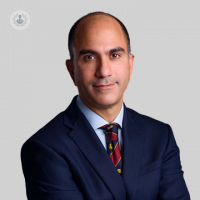Head and neck cancer explained
Written in association with:Head and neck cancer is a relatively uncommon type of cancer, with around 12,000 cases diagnosed in the UK each year.
Here, Mr Vikram Dhar, distinguished consultant ENT and head and neck cancer surgeon, shares his expert insight on the different types, the risk factors, and the diagnosis of head and neck cancer, as well as the support available for patients.

What are the risk factors for head and neck cancer?
When I started my career, head and neck cancer was prevalent amongst a particular subtype of the population. Primarily, elderly people, people who smoked, and people who drank too much alcohol.
In the last 10 to 20 years, we have understood that head and neck cancer can also occur in a slightly younger population, particularly for oropharyngeal cancer (primarily being the tongue base and the tonsils). Unfortunately, it’s not even uncommon to see patients in their 40s who have oropharyngeal cancer.
The reason for this change is the large uptick in the prevalence of HPV-induced cancers in the head and neck area. HPV (human papillomavirus) is a virus that almost everyone will be exposed to. In a subgroup of people, the virus can cause cancer years after exposure.
Hence, there are two distinct groups of people now that develop head and neck cancer:
- People who are healthy, non-smoking, non-drinking, and develop HPV-related cancer.
- People who have been exposed to smoking and excessive alcohol.
However, of course there are some people that don't fit into either group.
What are the different types of head and neck cancer, and their signs and symptoms?
Head and neck cancer is a broad term. There are multiple types, including:
Laryngeal cancer
Laryngeal cancer is cancer of the larynx (voice box). Up to 95 per cent of laryngeal cancers affect people who smoke.
The primary symptom of laryngeal cancer is voice change. In more advanced cases, laryngeal cancer can cause breathing problems. A noise known as stridor can develop, but generally in very late presentation.
Hypopharyngeal cancer
Hypopharyngeal cancer is cancer of the hypopharynx, the part of the body just before the oesophagus (foodpipe).
Typically, hypopharyngeal cancers present late, with either deep-seated ear pain or difficulty swallowing (dysphagia).
Oropharyngeal cancer
Oropharyngeal cancer is cancer of the oropharynx, which primarily includes the tongue base and the tonsils.
Typically, oropharyngeal cancers present with lumps in the neck and one-sided sore throat. People who have one-sided sore throat, one-sided ear pain, or other symptoms that are unilateral like that should go and see a doctor.
Bilateral symptoms, for example lymph nodes on both sides of the neck, need investigating as well.
Nasopharyngeal cancer
Nasopharyngeal cancer is cancer of the nasopharynx, the back of the nose.
Nasopharyngeal cancers often present with lymph nodes in the neck. Additionally, they can cause changes in the way the palate works and unilateral or bilateral glue ear. Hearing loss can also occur, because the tube that connects the ear and the nose is infiltrated by nasopharyngeal cancer, so fluid can appear behind the eardrum which then leads to conductive hearing loss.
How is head and neck cancer diagnosed?
We start by taking the patient’s medical history. Following this, a nasal endoscopy is performed to examine the back of the nose, the throat (the oropharynx and the voice box), and the tissue towards the foodpipe.
If something doesn’t look alright, then we take things further with different imaging modalities, such as ultrasound, MRI or CT scans. If there's a palpable lump in the neck, for example a lymph node, we often also ask the radiologist performing the ultrasound for a biopsy.
Sometimes, we order a PET scan, which is an all-over functional body scan to see whether there is hyperactive tissue or any distant metastasis.
The next step is to obtain a tissue diagnosis. Usually, this involves taking a sample from the concerned tissue for microscopic examination later on. In the larynx, this procedure involves passing a solid steel tube towards the voice box and obtaining a few millimetres of tissue with the use of some forceps. In the oropharynx, this procedure involves removing the tonsils and often obtaining a sample from there, the tongue base, or the back of the nose.
What are the latest research developments in head and neck cancer?
The main research in head and neck cancer can be split between oncological developments and surgical developments.
In terms of oncological developments, the most exciting facet is that of immunotherapy. Currently, immunotherapy is only used in the palliative setting. In the right circumstances it can considerably prolong survival. Going forward, I think that there are going to be more and more personalised treatments available based on the genetics of the tumour and each individual patient, which will hopefully lead to more focused and less harsh treatments for patients.
In terms of surgical developments, there is an advent of robotic surgery, which has the advantage of being able to look around corners. As a result, some tonsil cancers can now be excised robotically, whereas previously the only treatment option was chemoradiotherapy.
What is the prognosis for head and neck cancer?
The prognosis is wildly variable depending on certain factors, including:
- The individual patient: Elderly and vulnerable patients are potentially at higher risk.
- The site of the disease: There are certain sites where head and neck cancer can develop that have a better outcome than others.
- The extent of the disease: We generally stage head and neck cancer using a TNM staging system. The T describes the size and location of the tumour; the N describes the size and location of the nodal disease; the M describes if there is any distant metastasis. Sadly, the more advanced the disease the worse the outcome in terms of prognosis.
- Other comorbidities.
It’s impossible to say what the prognosis is for all of head and neck cancer. I would adopt a personalised approach.
What are the resources available to support people with head and neck cancer and their families?
We work amongst a multidisciplinary team, involving incredibly important people for head and neck cancer patients such as clinical nurse specialists, speech and language therapists, and dietitians. I think one area we really need to expand on is in the remit of psychologists, because the psychological impacts of having head and neck cancer is huge, not just for the patient but also for their family.
From the individual patient's perspective, it's incredibly important to talk through your concerns with the medical team around you, including the surgeon and the oncologist. It's often useful to write down all the questions you want to ask beforehand.
There are also support groups like Butterfly Thyroid Cancer Trust, Macmillan Cancer Support, ENT UK, and the British Association of Head & Neck Oncologists, with hugely valuable resources and useful information for head and neck cancer patients in the UK.
If you need treatment for head and neck cancer and you would like to consult your options with an expert, don't hesitate to reach out to Mr Vikram Dhar via his Top Doctors profile today.


